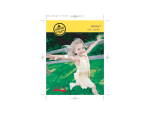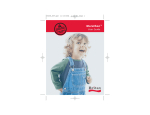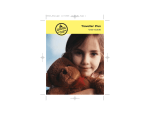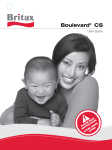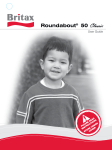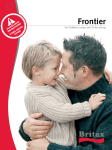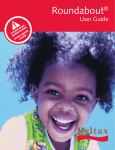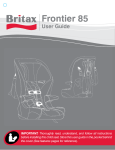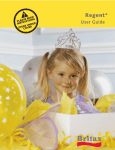Download Britax Baby-Safe User guide
Transcript
P2410_R01i.qxd 11/1/2004 10:51 AM Page 1 Baby Safe User Guide P2410_R01i.qxd 11/1/2004 10:51 AM Page 2 Table of Contents Safety Information . . . . . . . . . . . . . . . . . . . . . . . . . . . . . . . . . . . . . . . . . . . . 2 WARNINGS . . . . . . . . . . . . . . . . . . . . . . . . . . . . . . . . . . . . . . . . . . . . . . . . 2 Important Notes . . . . . . . . . . . . . . . . . . . . . . . . . . . . . . . . . . . . . . . . . . . . 4 Certification. . . . . . . . . . . . . . . . . . . . . . . . . . . . . . . . . . . . . . . . . . . . . . . . 5 Registration . . . . . . . . . . . . . . . . . . . . . . . . . . . . . . . . . . . . . . . . . . . . . . . . 5 Features . . . . . . . . . . . . . . . . . . . . . . . . . . . . . . . . . . . . . . . . . . . . . . . . . . . . 6 Front View . . . . . . . . . . . . . . . . . . . . . . . . . . . . . . . . . . . . . . . . . . . . . . . . 6 Rear View . . . . . . . . . . . . . . . . . . . . . . . . . . . . . . . . . . . . . . . . . . . . . . . . . 7 Base . . . . . . . . . . . . . . . . . . . . . . . . . . . . . . . . . . . . . . . . . . . . . . . . . . . . . 7 Basic Carrier Functions . . . . . . . . . . . . . . . . . . . . . . . . . . . . . . . . . . . . . . . . . 8 Buckle . . . . . . . . . . . . . . . . . . . . . . . . . . . . . . . . . . . . . . . . . . . . . . . . . . . . 8 Harness . . . . . . . . . . . . . . . . . . . . . . . . . . . . . . . . . . . . . . . . . . . . . . . . . . . 9 Chest Clip . . . . . . . . . . . . . . . . . . . . . . . . . . . . . . . . . . . . . . . . . . . . . . . . 10 Handle . . . . . . . . . . . . . . . . . . . . . . . . . . . . . . . . . . . . . . . . . . . . . . . . . . 11 Canopy . . . . . . . . . . . . . . . . . . . . . . . . . . . . . . . . . . . . . . . . . . . . . . . . . . 11 Using the Carrier . . . . . . . . . . . . . . . . . . . . . . . . . . . . . . . . . . . . . . . . . . . . 12 Securing Child in Carrier. . . . . . . . . . . . . . . . . . . . . . . . . . . . . . . . . . . . . . 12 Checking Harness Height . . . . . . . . . . . . . . . . . . . . . . . . . . . . . . . . . . . . . 14 Harness Height Adjustment . . . . . . . . . . . . . . . . . . . . . . . . . . . . . . . . . . . 15 Vehicle Compatibility . . . . . . . . . . . . . . . . . . . . . . . . . . . . . . . . . . . . . . . . . 16 Vehicle Safety Belts . . . . . . . . . . . . . . . . . . . . . . . . . . . . . . . . . . . . . . . . . 16 Vehicle Seating Positions . . . . . . . . . . . . . . . . . . . . . . . . . . . . . . . . . . . . . 17 Basic Base Functions. . . . . . . . . . . . . . . . . . . . . . . . . . . . . . . . . . . . . . . . . . 18 ISOFIX Connectors. . . . . . . . . . . . . . . . . . . . . . . . . . . . . . . . . . . . . . . . . . 18 Protective Sleeve . . . . . . . . . . . . . . . . . . . . . . . . . . . . . . . . . . . . . . . . . . . 18 Recline Adjustment . . . . . . . . . . . . . . . . . . . . . . . . . . . . . . . . . . . . . . . . . 19 Vehicle Belt Installation Spacer . . . . . . . . . . . . . . . . . . . . . . . . . . . . . . . . . 19 Foot Prop . . . . . . . . . . . . . . . . . . . . . . . . . . . . . . . . . . . . . . . . . . . . . . . . 20 Using Carrier with Base . . . . . . . . . . . . . . . . . . . . . . . . . . . . . . . . . . . . . . 21 Base Installation . . . . . . . . . . . . . . . . . . . . . . . . . . . . . . . . . . . . . . . . . . . . . 22 ISOFIX Installation . . . . . . . . . . . . . . . . . . . . . . . . . . . . . . . . . . . . . . . . . . 22 Lap-Shoulder Belt Installation . . . . . . . . . . . . . . . . . . . . . . . . . . . . . . . . . . 24 Lap Belt Installation . . . . . . . . . . . . . . . . . . . . . . . . . . . . . . . . . . . . . . . . . 26 Carrier Only Installation . . . . . . . . . . . . . . . . . . . . . . . . . . . . . . . . . . . . . . . 28 Lap-Shoulder Belt Installation . . . . . . . . . . . . . . . . . . . . . . . . . . . . . . . . . . 28 Lap Belt Installation . . . . . . . . . . . . . . . . . . . . . . . . . . . . . . . . . . . . . . . . . 30 Aircraft Installation . . . . . . . . . . . . . . . . . . . . . . . . . . . . . . . . . . . . . . . . . . 31 Care and Maintenance . . . . . . . . . . . . . . . . . . . . . . . . . . . . . . . . . . . . . . . . 32 Warranty . . . . . . . . . . . . . . . . . . . . . . . . . . . . . . . . . . . . . . . . . . . . . . . . . . 36 This product and its components are subject to change without notice. © 2 0 0 4 B r i t a x C h i l d S a f e t y, I n c . A l l r i g h t s r e s e r v e d . P r i n t e d i n U . S . A . BB0-627-00 / P241000 R1:09/04 P2410_R01i.qxd 11/1/2004 10:51 AM Page 4 • Use only in a rear facing position when using this restraint in the vehicle. This infant restraint cannot be used forward facing in a vehicle. • Use only with children who weigh between 4 and 22 pounds (2 and 10 kg) and whose height is 30 inches (76 cm) or less. • Snugly adjust the belts provided with this restraint around your child. A snug strap should not allow any slack. It lies in a relatively straight line without sagging. It does not press on the child’s flesh or push the child’s body into an unnatural position. • Secure this child restraint with the vehicle’s child restraint anchorage system if available or with a vehicle belt. • Follow all instructions labeled on the child restraint and in these written instructions. • Secure this child restraint even when it is not occupied. In a crash, an unsecured child restraint may injure vehicle occupants. • Consult your child’s doctor before using this child restraint. Some infants must be secured with a device that allows them to lie flat. • The primary protection for occupants of a vehicle in a collision is the structure of the vehicle itself; a child restraint will not protect an infant when the vehicle is seriously impacted. However, correctly installed, a child restraint will substantially improve the chances for survival in most crashes. Make sure that all users fully understand the correct ways to use this child restraint in a vehicle. • Always use foot prop when base is installed in vehicle! Foot prop must be in Installation Mode for proper carrier attachment to base. 2 • Never use the adjuster strap to lift or carry this child restraint. Doing so could cause damage to the harness adjuster and webbing. Always carry a child restraint by the handle or shell. • This child restraint must not be used in boats, or other non-certified applications. • NEVER leave child unattended. • NEVER place carrier on beds, sofas, or other soft surfaces. Infant carrier can roll over on soft surfaces and suffocate the child. • NEVER use in or on strollers unless approved by Britax. • NEVER install forward facing in a vehicle. • NEVER place carrier near edges of counter tops, tables, or other elevated surfaces. Child’s movement can slide carrier. • NEVER leave child carrier when straps are loose or undone. Child can strangle in loose restraint straps. • Use of carrier in shopping carts can be dangerous. • Watch your child closely when restraint is not installed in a vehicle to avoid tipping over and strangulation. • Harness must be used at all times when child is in carrier. WARNING! DO NOT place a child restraint in the front seat of a vehicle with a passenger air bag unless the air bag is turned off. DEATH or SERIOUS INJURY can occur. The back seat is the safest place for children under 12. 3 P2410_R01i.qxd 11/1/2004 10:51 AM Page 6 Safety Information Safety Information Important Notes • Verify that the child restraint is secure and that the harness is properly adjusted around the child each time the child restraint is used. • Adjust the harness to fit the clothes the child is wearing. The fit for a child in winter clothes will differ from a child in summer clothes. • Cover the restraint when the vehicle is parked in direct sunlight. Parts of the child restraint could become hot enough to burn the child. • Store the child restraint in a safe place when it is not being used for an extended period of time. Do not place heavy objects on top of it. • Stop use of a child restraint that is older than six years or has been in a severe crash to prevent injury due to deterioration or hidden damage. • Do not leave children alone in a vehicle, even for a short time. • Do not, except as described in this booklet, attempt to disassemble any part of the child restraint or change the way its harness or the vehicle belts are used. • Do not leave loose objects (e.g. books, bags, etc.) in the back of a vehicle. In the event of a sudden stop, loose objects will keep moving, potentially causing serious injuries. • Do not leave folding vehicle seats unlatched. In the event of a sudden stop, a loose seat back could prevent the child restraint from protecting the child as well as it should. • Do not allow children to play with the child restraint. • Do not hang accessories or toys from handle. Doing so could create a hazard for the child. 4 Weight Range Rear Facing ONLY 4–22 lbs. (2–10 kg) Maximum Height The child is too tall when the top of the head is above the top of the carrier or height exceeds 30 inches (76 cm). Certification This child restraint system conforms to all applicable Federal motor vehicle safety standards. This restraint is certified for use in motor vehicles and aircraft. Registration Visit BritaxUSA.com to register your restraint online! Child restraints could be recalled for safety reasons. You must register this restraint to be reached in a recall. Send your name, address, and the restraint's model number and manufacturing date to Britax Child Safety, Inc. 13501 South Ridge Drive Charlotte, NC 28273 or call 1-888-4BRITAX. For recall information, call the U.S. Government's Auto Safety Hotline at 1-888-327-4236. 5 P2410_R01i.qxd 11/1/2004 10:52 AM Page 8 Features Features 1 2 27 28 3 4 5 6 7 8 9 10 14 5 15 16 17 18 13 19 20 21 22 23 24 10 25 29 11 12 13 1 2 3 4 5 6 7 6 Canopy Handle Cover Head Support Pillow Harness Comfort Pad Chest Clip 8 9 10 11 12 13 Buckle Harness Adjuster Lever Harness Adjuster Strap Belly Pad Belt Guide Handle Release Button 14 15 16 17 18 19 20 21 22 Harness Slot Anti-Rebound Bar Lock-off Clip Belt Guide ISOFIX (LATCH) Connector ISOFIX (LATCH) Release Button Lock-off Lock-off Release Tab Carrier Release Button 26 23 24 25 26 27 28 29 Foot Prop Adjust Button Yoke Foot Prop Attachment Rod Vehicle Belt Installation Spacers ISOFIX Guides ISOFIX Protective Cap 7 P2410_R01i.qxd 11/1/2004 10:52 AM Page 10 Basic Carrier Functions Basic Carrier Functions Buckle Harness To fasten buckle, fit the two buckle tongues together (fig. A), then insert in buckle (fig. B). To loosen harness, press and hold harness adjuster lever, while pulling harness straps away from carrier. (fig. D). To tighten harness, pull harness adjuster strap away from carrier (fig. E). IMPORTANT: Proper connection of the buckle is confirmed with a positive click. To unfasten buckle, press release button until buckle tongues are ejected (fig. C). A D IMPORTANT: Periodically clean buckle to ensure safe operation. See Cleaning the Buckle on page 33. B E C 8 9 P2410_R01i.qxd 11/1/2004 10:52 AM Page 12 Basic Carrier Functions Basic Carrier Functions Chest Clip Handle Secure the chest clip by sliding the harness into the open slot (fig. A). Adjust chest clip to the center of the child’s chest, level with the armpits (fig. B). Release the chest clip by sliding the harness out of the open slot. The handle is designed to be adjusted to one of three positions: Sitting, In-Vehicle, or Carrying (fig. C). To adjust, press both handle release buttons while rotating handle into desired position. A Carrying In-Vehicle Sitting IMPORTANT: Always adjust handle to In- C Vehicle position while using in vehicle. Canopy To raise, pull canopy toward foot of carrier (fig. D). To collapse, push canopy toward head of carrier (fig. E). B D E 10 11 P2410_R01i.qxd 11/1/2004 10:52 AM Page 14 Using the Carrier Using the Carrier Securing Child in Carrier 1 2 3 4 5 6 7 8 9 Loosen harness completely (fig. A). Release the chest clip. Unfasten the buckle. Move the harness straps to the sides of the carrier. Place child in the carrier. A Position the harness straps over child’s shoulders. Fasten buckle. Secure chest clip (fig. B). Gently pull up on the harness straps to tighten the lap sections (fig. C). B 10 Slowly pull the harness adjuster strap to tighten harness for a snug fit (fig. D). 11 Position the chest clip at the center of the child’s chest, level with the child’s armpits. (fig. E). 12 Verify that harness is not twisted and all connections are secure. 13 Verify that harness height is correct. D • Refer to Checking Harness Height on page 14 for instructions. IMPORTANT: • Check the harness tightness before each use. • If buckle or harness will not secure properly, the buckle or adjuster may be clogged with food, drink, or other material that must be removed. See page 33 for cleaning instructions. E C 12 13 P2410_R01i.qxd 11/1/2004 10:52 AM Page 16 Using the Carrier Using the Carrier Checking Harness Height Harness Height Adjustment 1 Place child in carrier, then secure harness (see pages 12–13). 2 Observe where the harness is positioned on the child’s shoulders. 1 Loosen harness completely. 2 From the rear of the carrier, unhook the harness straps from the yoke (fig. A). 3 Lean head support pillow forward, then pull straps through the shell and cover. • Harness straps must be located at or slightly below the child’s shoulders. 3 If harness height is correct, continue using child carrier without adjustment. If harness height requires adjustment, refer to Harness Height Adjustment on page 15. Rear Facing Strap Height • It is not necessary to pull straps through A slots in the head support pillow. 4 Thread the harness straps through slots cover and shell, at the new height (fig. B). 5 Reattach harness straps to the yoke (fig. C). 6 Pull harness adjuster strap to tighten the harness. 7 Verify that all straps are threaded at the B same height and are not twisted. C 14 15 P2410_R01i.qxd 11/1/2004 10:52 AM Page 18 Vehicle Compatibility Vehicle Compatibility Vehicle Safety Belts Vehicle Seating Positions IMPORTANT: WARNING: • The information in this section only applies to installation with vehicle safety belts. • Some vehicles do not have seating positions which are compatible with this child restraint. If in doubt, contact the vehicle manufacturer. This child restraint can fit securely in most vehicles using the existing vehicle belts. However, some vehicle designs prevent a secure fit of the child restraint due to the position of the vehicle belt lower anchorage points. The owner's manual for your vehicle will have information on the types of vehicle belts in your vehicle. If your belt type is listed below, select another seating position or use ISOFIX connectors. The following types of vehicle belts are not compatible with this child restraint: Front vehicle belts with top or bottom anchorage points in the door. Motor driven automatic vehicle belts. Three-point belts that have separate retractors for the shoulder section and the lap section. 2-point Emergency Locking Retractor (ELR) vehicle belts without the use of a belt shortening clip. 16 • Forward facing vehicle seats MUST be used with this child carrier. Side facing or rear facing vehicle seats CANNOT be used. • DO NOT place a child carrier in the front seat of a vehicle with a passenger air bag, unless the air bag is turned off. DEATH or SERIOUS INJURY can occur. The back seat is the safest place for children under 12. 17 P2410_R01i.qxd 11/1/2004 10:52 AM Page 20 Basic Base Functions Basic Base Functions ISOFIX Connectors Vehicle Belt Installation Spacers The ISOFIX connectors should be in either ISOFIX Installation Mode (fig. A) or Vehicle Belt Installation Mode (fig. B). Due to varying locations of vehicle belt anchor points, the Vehicle Belt Installation Spacers must be used for a secure vehicle belt installation. To use spacers, insert one spacer on each side of anti-rebound bar (fig. C) before installing base with a vehicle belt. C A IMPORTANT: Spacers must be removed for ISOFIX installation. Recline Adjustment To adjust recline level, press both tabs while moving the recline block up (fig. D) or down (fig. E), to desired location. B ISOFIX Protective Cap The ISOFIX Protective Cap must be used when base is installed using vehicle belts. To attach Protective Cap, align with connectors as shown, then press until positive click is heard (fig. C). To remove Protective Cap, squeeze green and red ISOFIX release buttons, then pull cap off. C 18 IMPORTANT: Use level line indicator on carrier to assist with achieving correct recline angle. D If further recline adjustment is necessary, use a tightly rolled towel. WARNING: Only raise carrier as described above. Do not raise the carrier off of the front edge of the vehicle seat; doing so will reduce the protection for your child. E 19 P2410_R01i.qxd 11/1/2004 10:52 AM Page 22 Basic Base Functions Basic Base Functions Foot Prop Using Carrier with Base To use foot prop, press release button and compress foot prop, then swing foot prop up from base, into Installation Mode (fig. A). To attach, line up carrier with base, rear facing, then push down until positive click confirms correct attachment (fig. D). Check installation by lifting carrier from both ends to verify that both attachment rods are engaged with the base. Visual confirmation can be made, using the button indicator on the rear of the base D (fig. E). WARNING: • Always use foot prop when base is installed in vehicle! Foot prop must be in Installation Mode for proper carrier A attachment to base. • Never use foot prop to raise base above vehicle seat surface. Doing so will reduce the stability of the base. WARNING: Carrier must be attached properly to the base. When carrier is attached properly, the green indicator band on the release button is fully visible (fig. E). Adjust foot prop height by pressing Foot Prop Adjust Button while sliding foot prop to the shortest position that provides contact with the vehicle floor (fig. B). To store foot prop for transport outside of the vehicle, adjust to shortest position, then B collapse into Storage Mode (fig. C). Press tab into slot on bottom of base to secure. To release, press release button on base, then lift carrier to remove (fig. F). IMPORTANT: Always adjust handle to InVehicle position while using in a vehicle. E Indicator 1 2 C 20 E 21 P2410_R01i.qxd 11/1/2004 10:53 AM Page 24 Base Installation Base Installation 5 Adjust foot prop so that it is against the vehicle floor. ISOFIX Installation • Figure A illustrates a typical base ISOFIX installation. • Remove carrier before installing base. • Verify that your vehicle is equipped with ISOFIX anchors. If ISOFIX anchors are not available, you must use vehicle belt installation methods. WARNING: Never use foot prop to raise base above vehicle seat surface. Doing so will reduce the stability of the base. 6 Attach carrier to base. 1 Place ISOFIX connectors in ISOFIX A Installation Mode. • Remove ISOFIX Protective Cap and spacers, if installed. 2 Place foot prop in Installation Mode. • Always use foot prop when base is 3 Line up ISOFIX connectors on base with anchors in vehicle (fig. B). Removal • If it is difficult to line up ISOFIX connectors with ISOFIX anchors, use Insertion Aid for assistance, as instructed B on page 23. 4 Engage ISOFIX connectors by pressing base onto ISOFIX anchors, until a positive click is heard (fig. C). 22 Indicator 7 Adjust carrier handle to In-Vehicle position. installed in vehicle! • Visual confirmation can be made using the green ISOFIX indicators. Green indicator must be fully visible from the side when installed properly (fig. D). • Pull base away from vehicle seat to further verify attachment. • Verify that the green indicator band on the release button is fully visible. • Verify that the red line on carrier is level D with the ground. • If angle is not correct, remove carrier and base, then adjust recline angle as directed on page 19. Squeeze green and red ISOFIX release buttons on each connector (fig. D), then D pull base away from vehicle seat. IMPORTANT: Always store ISOFIX connectors when not in use. See page 18. ISOFIX Guides C If necessary, use ISOFIX Guides to assist with base attachment to ISOFIX anchors. To use, clip ISOFIX Guide onto each ISOFIX connector that will be used for installation of base (Fig. E). ISOFIX Guide E 23 P2410_R01i.qxd 11/1/2004 10:53 AM Page 26 Base Installation Base Installation Lap-Shoulder Belt Installation • Figure A illustrates a typical base lapshoulder belt installation. • Remove carrier before installing base. 1 Insert Vehicle Belt Installation Spacers and ISOFIX Protective Cap (pgs. 18-19). 2 Place foot prop in Installation Mode. • Always use foot prop when base is installed in vehicle! A 3 Place the base on the vehicle seat with the anti-rebound bar against the vehicle seat back and ISOFIX connectors in Vehicle Belt Installation Mode. 4 Place the ISOFIX Connectors, with protective cap installed, in the seat bight (where the seat back and seat cushion meet). B 5 Open lock-off by sliding clip out, then lifting release tab (fig. B). 6 With shoulder and lap portion of vehicle seat belt together, slide under both belt guides (fig. C). 7 Verify that the vehicle belt is not twisted, then buckle (fig. D). C 24 8 Press the base firmly into the seat while removing slack from the lap portion of the vehicle belt, then the shoulder portion (fig. E). 9 Close the lock-off over the vehicle belt (fig. F), then slide clip in to secure. 10 Verify that vehicle belt is tight and that the base is stable. D • Base is tight when it cannot be moved more than 1” (2.5 cm) at the belt path. 11 Adjust foot prop so that it is against the vehicle floor. WARNING: Never use foot prop to raise base above vehicle seat surface. Doing so will reduce the stability of the base. 12 Attach carrier to base. • Verify that the green indicator band on the release button is fully visible. E • Verify that the red line on carrier is level with the ground. • If angle is not correct, remove carrier and base, then adjust recline angle as directed on page 19. 13 Adjust carrier handle to In-Vehicle position. Removal Unbuckle vehicle belt, then open lock-off and remove vehicle belt from belt guides. F 25 P2410_R01i.qxd 11/1/2004 10:53 AM Page 28 Base Installation Base Installation 8 Press the base firmly into the seat while removing slack from the vehicle belt, (fig. E). 9 Close the lock-off over the vehicle belt (fig. F), then slide clip in to secure. 10 Verify that vehicle belt is tight and that the base is stable. Lap Belt Installation • Figure A illustrates a typical base lap belt only installation. • Remove carrier before installing base. 1 Insert Vehicle Belt Installation Spacers and ISOFIX Protective Cap (pgs. 18-19). 2 Place foot prop in Installation Mode. • Always use foot prop when base is installed in vehicle! A 3 Place the base on the vehicle seat with the anti-rebound bar against the vehicle seat back and ISOFIX connectors in Vehicle Belt Installation Mode. 4 Place the ISOFIX Connectors, with protective cap installed, in the seat bight (where the seat back and seat cushion meet). B 5 Open lock-off by sliding clip out, then lifting release tab (fig. B). 6 Slide vehicle belt under both belt guides (fig. C). 7 Verify that the vehicle belt is not twisted, then buckle (fig. D). • Base is tight when it cannot be moved D more than 1” (2.5 cm) at the belt path. 11 Adjust foot prop so that it is against the vehicle floor. WARNING: Never use foot prop to raise base above vehicle seat surface. Doing so will reduce the stability of the base. 12 Attach carrier to base. • Verify that the green indicator band on the release button is fully visible. • Verify that the red line on carrier is level E with the ground. • If angle is not correct, remove carrier and base, then adjust recline angle as directed on page 19. 13 Adjust carrier handle to In-Vehicle position. Removal Unbuckle vehicle belt, then open lock-off and remove vehicle belt from belt guides C 26 F 27 P2410_R01i.qxd 11/1/2004 10:53 AM Page 30 Carrier Only Installation Carrier Only Installation Lap-Shoulder Belt Installation • Figure A illustrates a typical rear facing lap-shoulder belt installation of carrier only. WARNING: Do not install this carrier using a non-locking ELR vehicle belt, unless a locking clip is used. Refer to the vehicle owner’s manual for instructions on correct A use of vehicle belts with child carriers. 1 Place the carrier rear facing on the vehicle seat. 2 With shoulder and lap portion of vehicle seat belt together, route through both belt guides (fig. B). 3 Verify that the vehicle belt is not twisted, then buckle (fig. C). WARNING: Only raise carrier as described above. Do not raise the carrier off of the B front edge of the vehicle seat; doing so will reduce the protection for your child. 4 Push the carrier firmly into the vehicle seat while removing slack from the lap portion of the vehicle belt, then the shoulder portion (fig. D). 5 Verify that vehicle belt is tight and that the carrier is stable. • Base is tight when it cannot be moved more than 1” (2.5 cm) at the belt path • Verify that the red line on carrier is level D with the ground. • If angle is not correct, loosen vehicle belt and adjust recline angle. • If there is a problem stabilizing the carrier or achieving necessary angle, place a tightly rolled towel in the crease of the vehicle seat to help level the carrier. 6 Adjust carrier handle to In-Vehicle position. C 28 29 P2410_R01i.qxd 11/1/2004 10:53 AM Page 32 Carrier Only Installation Carrier Only Installation 5 Adjust carrier handle to In-Vehicle position. 6 Verify that vehicle belt is tight and that the carrier is stable. Lap Belt Installation • Figure A illustrates a typical rear facing lap belt installation of carrier only. WARNING: Do not install this carrier using a non-locking ELR vehicle belt, unless a belt shortening clip is used. Refer to the vehicle owner’s manual for instructions on correct use of vehicle belts with child carriers. 1 Place the carrier rear facing on the A vehicle seat. 2 Route vehicle belt through both belt guides (fig. B). 3 Verify that the vehicle belt is not twisted, then buckle (fig. C). • When correctly reclined, the red line on carrier will be level with the ground. • If there is a problem stabilizing the carrier, place a rolled towel in the crease of the B vehicle seat to help level the carrier. WARNING: Only raise carrier as described above. Do not raise the carrier off of the front edge of the vehicle seat; doing so will reduce the protection for your child. 4 Push the carrier firmly into the vehicle seat while removing slack from the vehicle belt (fig. D). C 30 • Base is tight when it cannot be moved more than 1” (2.5 cm) at the belt path • Verify that the red line on carrier is level with the ground. • If angle is not correct, loosen vehicle belt D and adjust recline angle. • If there is a problem stabilizing the carrier or achieving necessary angle, place a tightly rolled towel in the crease of the vehicle seat to help level the carrier. Aircraft Installation This child carrier is certified for use in aircraft. Most airlines in the U.S. and Canada will allow the use of a child carrier if it is labeled as an approved child carrier for airline use and fits properly on the aircraft. Contact the airline about their policy prior to traveling. To install in aircraft, follow instructions for Carrier Only Lap Belt Installation on page 30. • Place the carrier next to a window to avoid blocking the aisle. • If the aircraft belt is too short, ask the flight attendant for a Belt Extender. 31 P2410_R01i.qxd 11/1/2004 10:53 AM Page 34 Care and Maintenance Care and Maintenance Buckle Removal Cleaning the Buckle 1 From the bottom of the carrier, locate metal buckle strap retainer. 2 Pull retainer away from carrier to loosen. 3 Turn the retainer so that the short side will go through the A slot in the carrier shell to the opposite side of the carrier (fig. A). 4 Thread the retainer through the hole in cover to remove buckle from carrier. If a child eats and drinks while in the carrier, the buckle may need to be periodically checked and cleaned of any accumulated debris or dried liquids. • THOROUGHLY RINSE, using warm water (fig. C). • SOAK, overnight if possible, using warm water to loosen hardened C drinks or food. • TEST THE BUCKLE, by fastening and unfastening until a positive click is heard. If a click is not heard, repeat cleaning procedure. • TOWEL DRY • DO NOT: Lubricate, use solvents, abrasive cleaners, soap or household detergents. Buckle Installation 1 Turn the buckle retainer (fig. B) so that the short side will go through the slot in the cover and carrier shell. 2 Pull buckle away from carrier until B Buckle Retainer tight, then verify that the strap is not twisted and the release button is facing outward. IMPORTANT: Verify that retainer is threaded through both the cover AND the shell. 32 33 P2410_R01i.qxd 11/1/2004 10:53 AM Page 36 Care and Maintenance Care and Maintenance Cover Removal 1 Unhook attachment loops. 2 Loosen harness completely. 3 From the bottom of the carrier, unhook both harness straps from the yoke. 4 From the top of the carrier, pull each harness strap through the upper harness slot, head support pillow and cover slot to the top of the carrier. 5 Unfasten buckle. 6 Pull the harness straps, buckle tongues, and chest clip through the slots in the cover. 7 Remove buckle and belly pad. 8 Remove cover and head support pillow from the carrier. WARNING: • Do not take harness apart or completely remove from carrier. It is unnecessary and dangerous to do so. • Never remove the buckle tongues from the harness. They cannot be reattached after removal. Refitting the Cover Cleaning the Cover, Belly pad & Head Support Pillow • HAND WASH, using cold water and mild soap. • LINE DRY, to prevent shrinkage. • DO NOT: Bleach, machine wash, machine dry, or iron. Cleaning the Shell & Harness • BRUSH AWAY LOOSE DEBRIS, using a soft bristled brush. • SPONGE CLEAN, using warm water and mild soap. • TOWEL DRY • DO NOT: Use solvents, abrasive cleaners, or bleach. Do not machine wash, machine dry, or disassemble the harness. Cleaning the Harness Adjuster WARNING: Periodically check the adjuster area to be sure it is clean and free of food, coins, dirt, and other objects. If debris is present, it must be removed to prevent interference with the adjuster mechanism. • BRUSH AWAY LOOSE DEBRIS, using a soft bristled brush. • SPONGE CLEAN, using warm water and mild soap. • TOWEL DRY • DO NOT: Use solvents, abrasive cleaners, or disassemble the harness. To refit the cover, reverse Cover Removal directions. Make sure that the harness is not twisted. 34 35 P2410_R01i.qxd 11/1/2004 10:53 AM Page 38 Warranty This child restraint was manufactured by Britax. Britax Child Safety, Inc. (“Britax”) warrants this product to the original retail purchaser as follows: LIMITED ONE-YEAR WARRANTY This product is warranted against defective materials or workmanship for one year from the date of original purchase. Proof of purchase is required. The exclusive remedy for this warranty is that Britax will, at its option, provide repair or replacement components for this product or refund the original purchase price of the product. Britax reserves the right to discontinue or change fabrics, parts, models or products, or to make substitutions. To make a claim under this warranty, contact Britax Consumer Services at 1-888-427-4829 or write to us using the address on the back cover of this booklet. Proof of purchase is required. PLEASE COMPLETE AND MAIL THE OWNER REGISTRATION CARD WITHIN (30) DAYS OF PURCHASE. WARRANTY LIMITATIONS This warranty does not include damages which arise from negligence, misuse or use not in accordance with the product instruction. The use of non-Britax Child Safety, Inc. covers, inserts, toys, accessories, or tightening devices is not approved by Britax. Their use could cause this restraint to fail Federal Safety Standards or perform worse in a crash. Their use automatically voids the Britax warranty. LIMITATION OF DAMAGES The warranty and remedies as set forth above are exclusive and in lieu of all others, oral or written, express or implied. In no event will Britax, or the retailer selling this product, be liable for any damages, including incidental or consequential damages, arising out of the use or inability to use this product. LIMITATIONS OF WARRANTIES AND OTHER WARRANTY TERMS AND STATE LAWS Any implied warranties, including implied warranties of merchantability and fitness for a particular purpose, shall be limited to the duration and terms of the express written warranty. Some states do not allow limitations on how long an implied warranty lasts or the exclusion or limitation of incidental or consequential damages, so the above limitations may not apply. This warranty gives you specific legal rights, and you may have other rights, which vary from state to state. Neither Britax, nor the retailer selling this product, authorizes any person to create for it any other warranty, obligation, or liability in connection with this product. 36 P2410_R01i.qxd 11/1/2004 10:54 AM Page 40





















